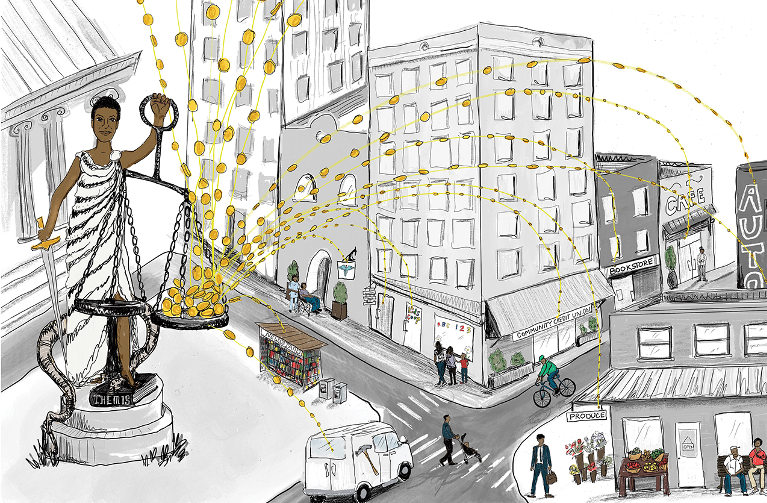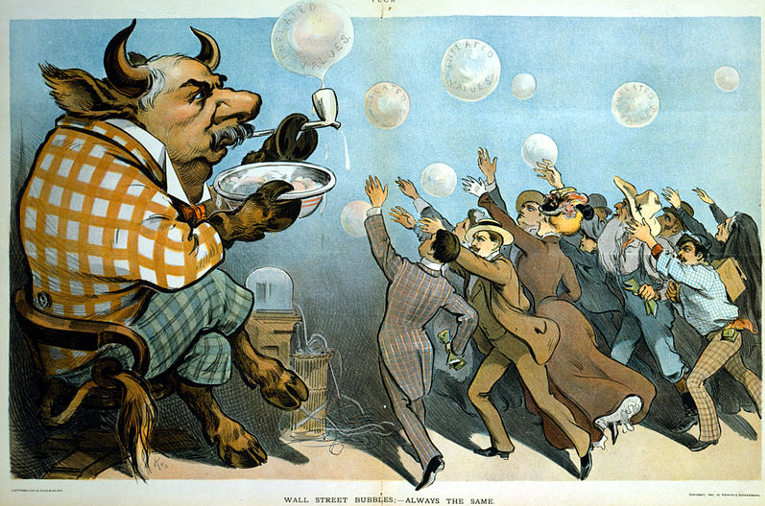In the early months of 2020, as the COVID-19 pandemic began to put enormous pressure on the economy, Rodney Foxworth saw a parallel crisis emerging among businesses led by people of color. They needed capital and couldn’t get it.
“Obviously this was a pre-standing issue prior to the COVID-19 pandemic,” says Foxworth, the CEO of Common Future, a small-business support network based in Oakland, California.
Traditionally, support for small businesses comes from organizations like Community Development Financial Institutions, or CDFIs, which have long been seen as a way to invest in historically excluded communities. But CDFIs, many of which are federally chartered, are still part of the mainstream banking economy, which means they need to meet risk underwriting and reporting requirements, and often need to show returns, even if those requirements are less stringent than those at commercial banks.
At the local level, organizations within communities of color often have better ties to local businesses, and would be in a better position to meet their needs, if they had the capital.
Foxworth and his team saw an opening: draw on Common Future’s national network of businesses, funders, and support groups—many owned by people of color and especially women of color—to create a fund that could be disbursed to community support groups, who in turn could make low- to no-interest loans to local businesses that need them. This would bypass much of the traditional financial system, with its credit scoring and extractive interest rates, and put the control back into the hands of the community.
A Matter of Character
Most traditional lending is based on credit scores: numbers derived from borrowers’ history of paying back debt, their income, the value of their assets, and other criteria.
Credit scores are not racially neutral, however, as many borrowers of color do not have the level of income, assets, or inherited wealth to draw on that white people do. Even after setting aside cases of intentional discrimination, such as with auto pricing and loans, many business owners of color lack credit because their communities lack banks or other financial services, leaving people to be exploited by predatory institutions like payday lenders. That absence further translates into a lack of opportunity for entrepreneurs of color to build relationships with providers of capital. As a result, the entire financial system reinforces existing racial and gender inequities.
Character-based lending aims to address some of these inequities. Broadly speaking, it’s the practice of issuing loans based primarily on the borrower’s character—their involvement in and ties to the community, or their reputation and track record therein—relegating financial criteria to a smaller role in decision-making.
The Seattle-based Community Credit Lab has used character-based lending since 2019 to overcome systemic obstacles and create more avenues for people of color to obtain capital and credit.
“A lot of what shapes why Community Credit Lab exists today is through a lot of conversations we’ve had in this ecosystem about how people are accessing credit—what are those barriers, as well as understanding what are those gaps in the system,” says Sandhya Nakhasi, the organization’s chief investment officer.
Community Credit Lab works with community development organizations across the country to design lending programs that turn traditional risk analysis on its head, helping those businesses that otherwise wouldn’t be able to obtain affordable credit to do so.
A century ago, there were more than 30,000 banks in the U.S., and personal connections formed the basis of the borrower-bank relationship. (The number dropped during the Great Depression, and then somewhat rebounded by the 1960s. A wave of mergers and acquisitions, especially since the 1980s, has left the country with just 5,000 banks today, according to the FDIC, plus another 5,100 credit unions insured by the National Credit Union Administration.) Character-based lending puts the power and decision-making into the hands of organizations already working within their communities. This isn’t a lack of standards, but a shift in emphasis away from a single numeric distillation of someone’s credit history to a more holistic assessment of a business’s tenure and value in its community.
“The primary underwriting tool is the relationship [borrowers] hold with the people they work with,” Nakhasi says of the credit lab’s lending relationships.
These lending programs are replicable and adaptable for many communities, says Ryan Glasgo, Community Credit Lab’s chief operating officer. But as a loan-issuing organization, the main bottleneck it faces is the amount of capital it can access to lend out.
That’s where Common Future comes in.
Bringing It All Together
In mid-2021, Common Future launched an $800,000 fund, raised from a combination of philanthropic organizations and its donor network, and designed a program to offer below-prime 0–3% interest loans through three nonprofits in Black and Indigenous communities. (Small Business Administration loans typically carry interest rates of 5.5% or more, based off the prime rate of 3.25%.) Community Credit Lab serves as the underwriting body; it designs and issues the loans. Foxworth says the plan is for the three community groups to issue the loans over the next year and a half to entrepreneurs in three Black or Indigenous communities.
The key local partners are small groups who intimately know their communities, and will in turn make the financing decisions, while Common Future also provides many back-office functions, legal work, and the like, which are often out of reach for new businesses with tight budgets.
One such local partner is the ConnectUp! Institute in St. Paul, Minnesota, a networking and business development group. Character-based lending is a natural fit for ConnectUp! because it builds on personal relationships within a community, much the way rural farmers would know their local bank manager in the town center, explains Elaine Rasmussen, the organization’s founder. In the U.S., that kind of relationship historically was restricted to white business owners. But globally, the concept isn’t novel.
“It’s not anything new, particularly when you look at African countries and you look at the concept of sou-sou—shared funds,” she adds. What is new is the intentionality of focus on communities bypassed by traditional lenders. “It’s about undoing the harm of structural racism. It’s about getting back to those roots.”
ConnectUp!’s new partnership with Common Future targets what Rasmussen calls the “missing middle” of entrepreneurship: businesses that are 3–5 years old, no longer eligible for many startup support programs, yet not large enough to be able to pursue many traditional financing opportunities.
The Census Bureau estimates there are about 124,000 Black-owned businesses with employees, making up 2.2% of 5.7 million total U.S. employer businesses. Yet as further data from the Federal Reserve and reported by NerdWallet revealed, Black and Indigenous businesses receive less funding, get smaller loans, and pay higher interest rates than white businesses.
With Common Future’s support, Rasmussen anticipates helping businesses get loans from $20,000–$100,000. ConnectUp!’s lending conditions include consistent revenue generation for 24 months. “It’s to be sure they’re truly running a business, as opposed to a side hustle,” she explains. “The heavy lifting Common Future did for us was to free us up to be able to do additional fundraising.” She anticipates making loans to 8–10 local businesses over the next six months.
Community Strengths
Vanessa Roanhorse, a business consultant in Albuquerque, New Mexico, is another participant in Common Future’s new pilot program. Roanhorse, a member of the Navajo Nation, is one of the co-founders of Native Women Lead, a volunteer-led networking and business development group that invests in Native-women-led businesses in Arizona, Colorado, Utah, and New Mexico.
The 4-year-old group invested $12,500 in nine businesses in 2020, and also recently ran a loan fund that issued $150,000 in 0% loans to 35 businesses. A third lending program planned for early 2022 is a $10 million integrated capital fund that will issue some combination of loans or grants ranging from $50,000 to $250,000.
“We’ve been testing character-based lending for four years,” Roanhorse says. “When Common Future and Community Credit Lab came up with this product, we were ready.”
Women are breadwinners in two-thirds of Native American and Alaska Native families, and are paid just 58 cents for every dollar paid to white non-Hispanic men. There are few, if any, banks in Native lands, and treaties prevent many Indigenous people from building equity in land. “Entrepreneurship is one pathway Indigenous women can use to close their own racial wealth gap,” says Jaime Gloshay, another of Native Women Lead’s co-founders. Indigenous women entrepreneurs, she says, bring a set of values to their businesses, because they are concerned about climate change, caring for children and elders, and not exploiting natural resources or other people.
But getting capital in the first place has always been a challenge.
“What Native Women Lead recognized early on, in the first year, is that there was no safe place to get capital for women,” Roanhorse says. For many business owners she worked with, getting a loan through Native Women Lead was the first non-extractive loan experience they’d had.
That’s similar to the case with Common Future’s third partner, Mortar Cincinnati, a business training academy focused mainly on Black and Brown entrepreneurs in the Midwest.
“[The program] gives our folks an opportunity to have access to capital that they otherwise may not have,” says De’Marco Kidd, Mortar’s alumni manager.
Kidd says that Mortar’s alumni network is built around maintaining those community relationships as the member businesses grow and become successful. The funding opportunity through Common Future, he adds, will allow those businesses to build their own capital to pay back the loan so that they later can approach traditional banks. That helps create a foundation of community wealth.
“We have not been able to do that, especially in Black and Brown communities, as far as passing on business and financial wealth,” Kidd says. But these new programs give the entrepreneurs “more opportunities to create legacies for themselves and their families.”
Becoming Self-Sustaining
Common Future’s Foxworth says that the initial outlay to three organizations is just the beginning; the plan is to grow the program with capital obtained from repaid loans and from more philanthropic sources, to include other partner organizations who are best positioned to serve their communities.
“The whole purpose of character-based lending is in fact to strengthen the power and capacities of the folks in our network to maintain and build on these things themselves,” Foxworth says. “For Common Future to exert any power in the decision-making process, that completely negates that purpose. We trust them, we’re putting the money where our mouths are.”
For Foxworth, success is not defined solely by the loan recipient’s ability to become financially independent and repay the loan. He wants Common Future to be a model for other investors. “Not only is it possible to do this,” he says, “[but] we should have the expectation that communities are able to do this.”
Teaser credit: ILLUSTRATION BY JANA FREDERICK SANDERS/YES! MAGAZINE





